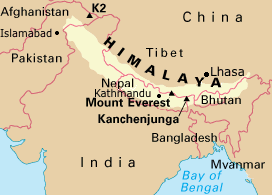 The Himalayas include over a hundred mountains exceeding 7,200 metres (23,600 ft) in height. By contrast, the highest peak outside Asia--Aconcagua, in the Andes-- is 6,961 metres (22,838 ft) tall.
The Himalayas include over a hundred mountains exceeding 7,200 metres (23,600 ft) in height. By contrast, the highest peak outside Asia--Aconcagua, in the Andes-- is 6,961 metres (22,838 ft) tall.
According to the modern theory of plate tectonics, their formation is a result of a continental collision or orogeny along the convergent boundary between the Indo-Australian Plate and the Eurasian Plate abut 50 million years ago. So the Himalayas are among the youngest mountain ranges on the planet.
|
| Mountain | m. | ft. | Country |
| Everest | 8,848 | 29,035 | Nepal/China |
| Lhotse | 8,516 | 27,941 | Nepal/China |
| Makalu | 8,463 | 27,767 | Nepal/China |
| Cho Oyu | 8,153 | 26,750 | Nepal |
| Kangchenjunga | 8,586 | 28,171 | Nepal/India |
| Lönpo Gang | 6,979 | 22,898 | |
| Ganesh Himal | 7,429 | 24,375 | Nepal/China |
| Annapurna | 8,091 | 26,547 | Nepal |
| K2 | 8,612 | 28,253 | Pakistan/China |
|
| City | Elevation (ft) | Population |
| Lhasa, Tibet | 11,900' | 500,000 |
| Shigatse, Tibet | 12,660' | 63,000 |
| Tingri, Tibet | 14,400' | 523 |
| Kathmandu, Nepal | 4,500' | 975,453 |
| Lukla, Nepal | 9,383' | 230 |
| Pokhara, Nepal | 5,710' | 264,991 |
|
 Places
Places
 Tibet
Tibet
 Himalaya
Himalaya
 Places
Places
 Tibet
Tibet
 Himalaya
Himalaya
 The Himalayas include over a hundred mountains exceeding 7,200 metres (23,600 ft) in height. By contrast, the highest peak outside Asia--Aconcagua, in the Andes-- is 6,961 metres (22,838 ft) tall.
The Himalayas include over a hundred mountains exceeding 7,200 metres (23,600 ft) in height. By contrast, the highest peak outside Asia--Aconcagua, in the Andes-- is 6,961 metres (22,838 ft) tall.